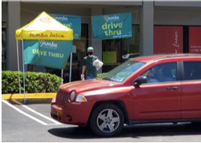Let’s face it: we really do not know how this crisis will play out, and therefore the implications to restaurant design remain just as uncertain. As such, the impact on restaurant design will remain a moving target for the foreseeable future.
To successfully navigate such a future, operators will need to take a transformational approach, one that embraces the spirit of continuous improvement and evolution, as the market evolves into the new normal.
This applies to the design of new prototypes and to existing locations. It also affects how restaurants deploy labor to deliver an optimum guest experience.
Indeed, as much as designs and facility usage will continuously evolve, so will labor requirements and guidelines. Factors shaping labor requirements include changing customer demands, government-imposed regulations and even some additional regulations imposed by the restaurant operation. Any one of these will necessitate a change in the labor model as these areas evolve into the new normal. No matter how much things change, a constant will be the need for restaurants to deploy the right labor in the right place at the right time to deliver the best customer service possible. One question that concepts should ask is whether their labor management systems can adapt to meet the challenges of the day. Do they have a proactive or reactive labor management system?
As operations prepare for whatever the new normal may bring, here are some questions to ask that will influence, design, labor and more:
- How do you efficiently serve the different customers, such as takeout and delivery customers vs. guests that chose to dine on premises? The goal is to ensure a good experience for everyone, which impacts design and labor. Part of the answer to this question includes making predictions on the rate customers will return to the restaurant to dine in. It will likely be slow and steady, and driven by the guests’ comfort level and what steps the concepts take to assure guests of a safe environment.
- What makeshift or temporary changes made to weather the pandemic will become permanent? Some of these include selling food components (raw or precooked) for customers to finish at home, make-shift drive-thrus and curbside systems.
- What is the vision for front-of-house service moving forward? Will guests order from their tables using smartphone apps? Will guests still be required to approach the front counter to pay their tabs? What does the future hold for self-service elements such as soft drink and condiment stations? How will food arrive at guests’ tables? McDonald’s in the Netherlands is considering meal trolleys, hand sanitizing stations in many places and customer waiting spots.
- In the case of fine-dining restaurants, how will the role of the front-of-house staff evolve? Historically, these individuals played a huge role in positively shaping the guest experience.
As you can imagine, the customer experience will be very different than it was prior to the pandemic. For the foreseeable future, there will be fewer orders for on-premises dining and more off-premises, including takeout, curbside, drive-thru and delivery. When dining rooms do reopen, there may be fewer groups of customers and more individuals eating on-site. Some states now limit the size of a group that can dine together to six or fewer people.
In other words, off-premises service will remain a center-of-the-plate option for quite some time. All concepts will have to continue to develop optimum ways to execute off-premises service systems and have the optimum labor to deploy and execute these. For example, Shake Shack intends to add a pickup window to its platform.
 Changes in the way customers use restaurants will lead to changes in design, which will likely result in changes in real estate demand. For example, out of necessity, many concepts have had to execute curbside by using available parking spots. Near my house, a concept developed a drive-thru in the parking lot. Similarly, parking lots have been converted to curbside areas, especially in the full-service restaurant category, to serve customers that pre-order.
Changes in the way customers use restaurants will lead to changes in design, which will likely result in changes in real estate demand. For example, out of necessity, many concepts have had to execute curbside by using available parking spots. Near my house, a concept developed a drive-thru in the parking lot. Similarly, parking lots have been converted to curbside areas, especially in the full-service restaurant category, to serve customers that pre-order.
Looking ahead, will the use of these spaces become more prevalent? If so, it will impact how the restaurants use parking lots, including the flow of guests onto and off of the property. This will give way to different equipment and technology to safely manage and store the food to keep it close to the pickup point. All these possibilities will not only impact design and labor deployment but also what type of real estate will best suit the operation in the future.
Indeed, the pandemic will, in fact, come to an end one day. As the world evolves to this end, restaurants will also have to evolve and continually improve as these consumer behavioral changes are happening to make sure that they meet these changes optimally. Consider where we are heading now, as we come out of the initial impact of the pandemic as the beginning of the changes that restaurants will have to make to remain relevant.
Whether you are a brand owner, an equipment and technology supplier, a design firm, or an Industrial Engineering consultant, like our group, I believe that it is key to have a “transformational” philosophy and “continuous improvement” and evolution approach and mentality, as we begin the journey out of the current pandemic. This will enable one to be nimble and adjust as the markets and the consumers will dictate it.





